Case Study Analysis: Project Management of Rapid Prototyping Project
VerifiedAdded on 2020/03/01
|8
|1381
|12
Report
AI Summary
This report analyzes a project management case study focusing on the challenges encountered during a rapid prototyping project. The case study examines the project's failure due to unclear specifications, inexperienced personnel, and inadequate project methodologies. It identifies the problem definition, possible causes such as communication gaps and undefined project scope, and lessons learned from the project's shortcomings. The report further discusses the responsibilities for the financial implications of the project's failure and proposes recommendations for improved project management, including the need for clear communication, detailed project plans, and proper testing. The conclusion emphasizes the importance of effective project management methodologies to avoid similar issues in future projects.

Running head: PROJECT MANAGEMENT
Project Management
Name of the Student
Name of the University
Author Note
Project Management
Name of the Student
Name of the University
Author Note
Paraphrase This Document
Need a fresh take? Get an instant paraphrase of this document with our AI Paraphraser
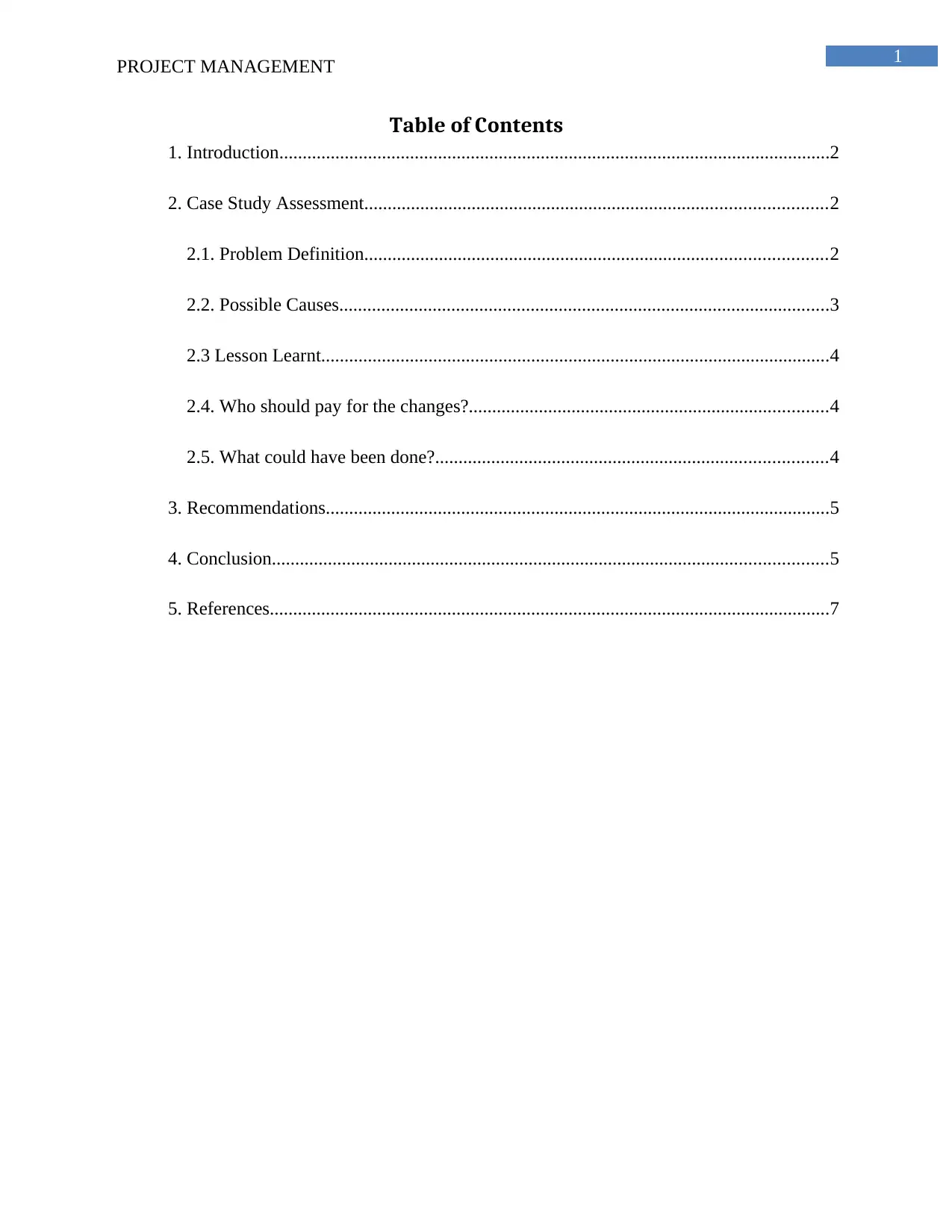
1
PROJECT MANAGEMENT
Table of Contents
1. Introduction......................................................................................................................2
2. Case Study Assessment...................................................................................................2
2.1. Problem Definition...................................................................................................2
2.2. Possible Causes.........................................................................................................3
2.3 Lesson Learnt.............................................................................................................4
2.4. Who should pay for the changes?.............................................................................4
2.5. What could have been done?....................................................................................4
3. Recommendations............................................................................................................5
4. Conclusion.......................................................................................................................5
5. References........................................................................................................................7
PROJECT MANAGEMENT
Table of Contents
1. Introduction......................................................................................................................2
2. Case Study Assessment...................................................................................................2
2.1. Problem Definition...................................................................................................2
2.2. Possible Causes.........................................................................................................3
2.3 Lesson Learnt.............................................................................................................4
2.4. Who should pay for the changes?.............................................................................4
2.5. What could have been done?....................................................................................4
3. Recommendations............................................................................................................5
4. Conclusion.......................................................................................................................5
5. References........................................................................................................................7
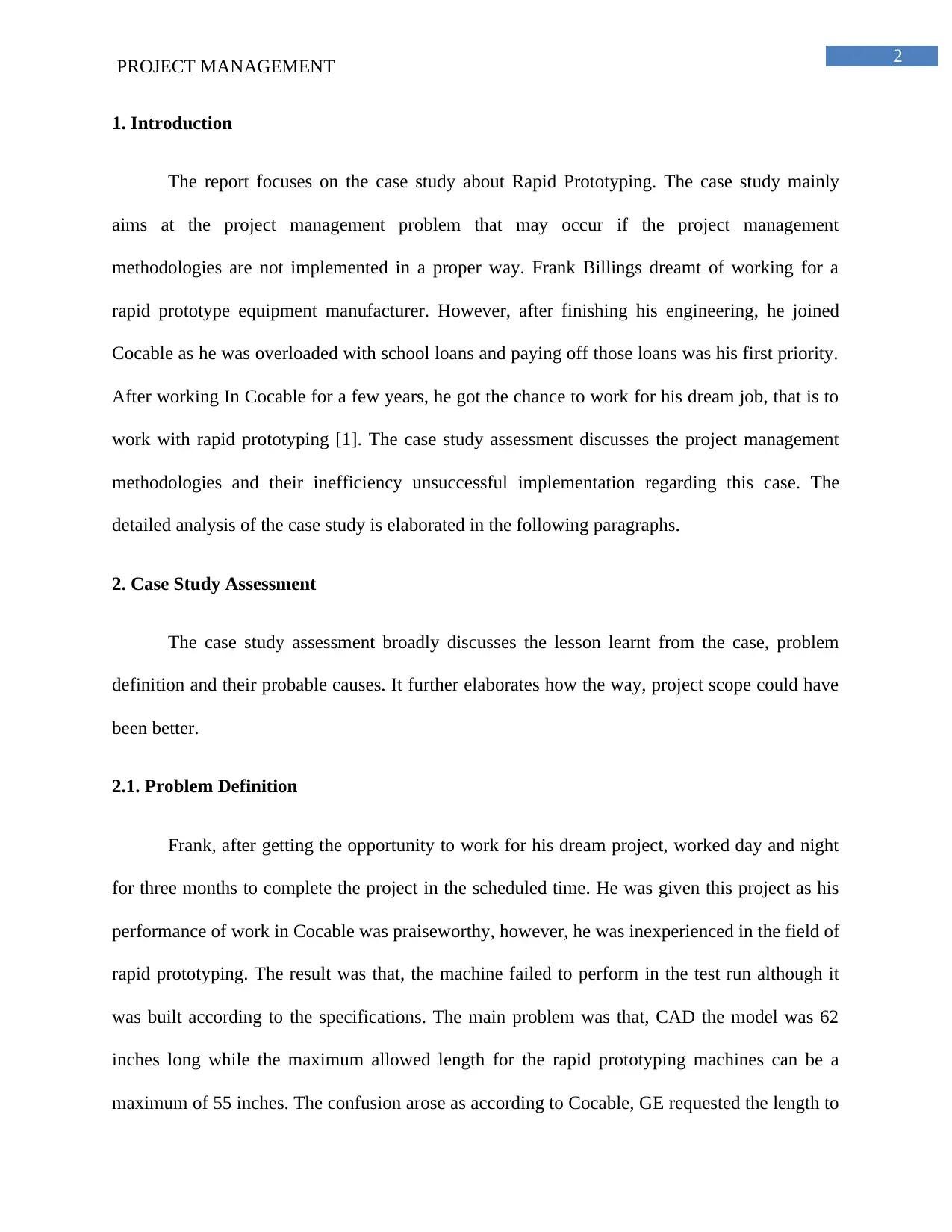
2
PROJECT MANAGEMENT
1. Introduction
The report focuses on the case study about Rapid Prototyping. The case study mainly
aims at the project management problem that may occur if the project management
methodologies are not implemented in a proper way. Frank Billings dreamt of working for a
rapid prototype equipment manufacturer. However, after finishing his engineering, he joined
Cocable as he was overloaded with school loans and paying off those loans was his first priority.
After working In Cocable for a few years, he got the chance to work for his dream job, that is to
work with rapid prototyping [1]. The case study assessment discusses the project management
methodologies and their inefficiency unsuccessful implementation regarding this case. The
detailed analysis of the case study is elaborated in the following paragraphs.
2. Case Study Assessment
The case study assessment broadly discusses the lesson learnt from the case, problem
definition and their probable causes. It further elaborates how the way, project scope could have
been better.
2.1. Problem Definition
Frank, after getting the opportunity to work for his dream project, worked day and night
for three months to complete the project in the scheduled time. He was given this project as his
performance of work in Cocable was praiseworthy, however, he was inexperienced in the field of
rapid prototyping. The result was that, the machine failed to perform in the test run although it
was built according to the specifications. The main problem was that, CAD the model was 62
inches long while the maximum allowed length for the rapid prototyping machines can be a
maximum of 55 inches. The confusion arose as according to Cocable, GE requested the length to
PROJECT MANAGEMENT
1. Introduction
The report focuses on the case study about Rapid Prototyping. The case study mainly
aims at the project management problem that may occur if the project management
methodologies are not implemented in a proper way. Frank Billings dreamt of working for a
rapid prototype equipment manufacturer. However, after finishing his engineering, he joined
Cocable as he was overloaded with school loans and paying off those loans was his first priority.
After working In Cocable for a few years, he got the chance to work for his dream job, that is to
work with rapid prototyping [1]. The case study assessment discusses the project management
methodologies and their inefficiency unsuccessful implementation regarding this case. The
detailed analysis of the case study is elaborated in the following paragraphs.
2. Case Study Assessment
The case study assessment broadly discusses the lesson learnt from the case, problem
definition and their probable causes. It further elaborates how the way, project scope could have
been better.
2.1. Problem Definition
Frank, after getting the opportunity to work for his dream project, worked day and night
for three months to complete the project in the scheduled time. He was given this project as his
performance of work in Cocable was praiseworthy, however, he was inexperienced in the field of
rapid prototyping. The result was that, the machine failed to perform in the test run although it
was built according to the specifications. The main problem was that, CAD the model was 62
inches long while the maximum allowed length for the rapid prototyping machines can be a
maximum of 55 inches. The confusion arose as according to Cocable, GE requested the length to
⊘ This is a preview!⊘
Do you want full access?
Subscribe today to unlock all pages.

Trusted by 1+ million students worldwide
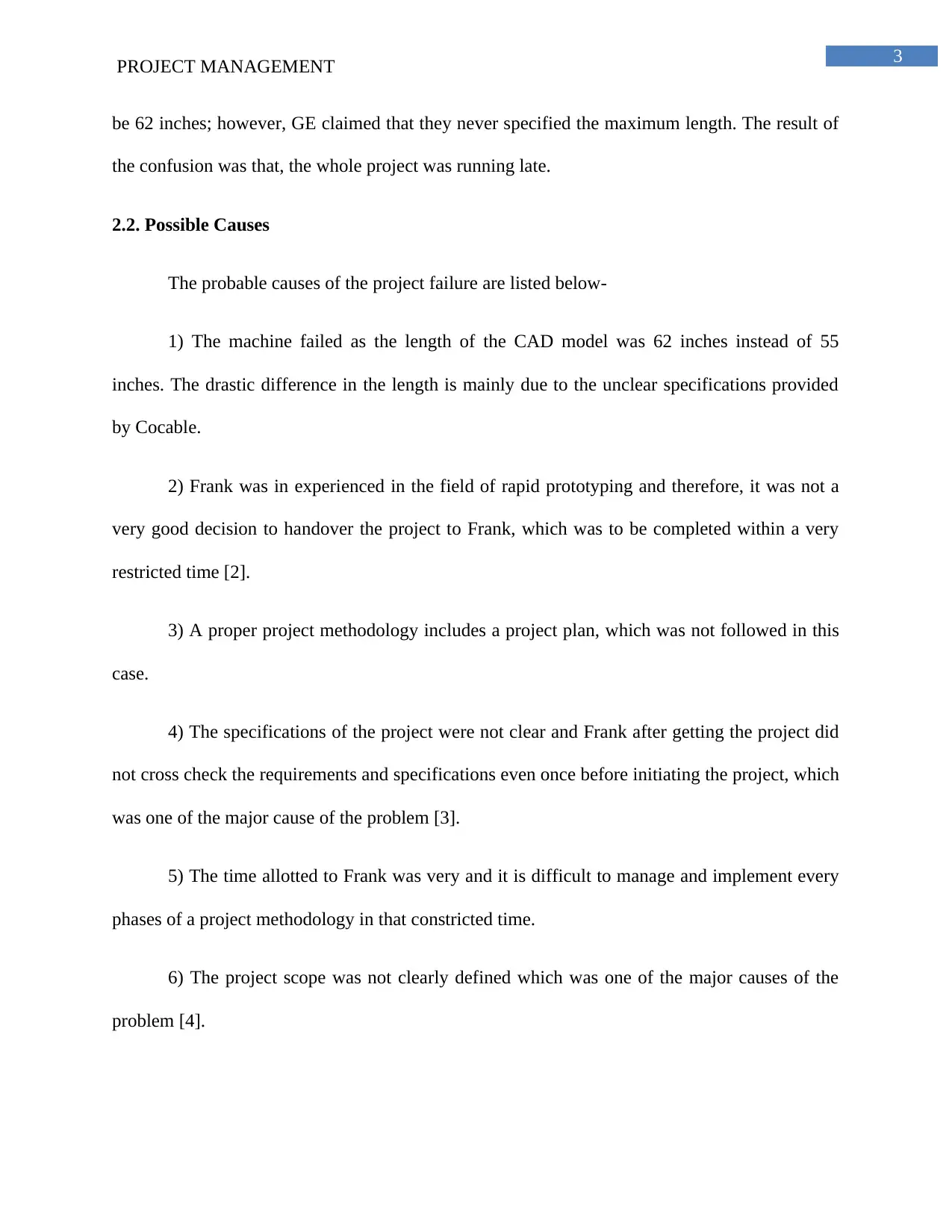
3
PROJECT MANAGEMENT
be 62 inches; however, GE claimed that they never specified the maximum length. The result of
the confusion was that, the whole project was running late.
2.2. Possible Causes
The probable causes of the project failure are listed below-
1) The machine failed as the length of the CAD model was 62 inches instead of 55
inches. The drastic difference in the length is mainly due to the unclear specifications provided
by Cocable.
2) Frank was in experienced in the field of rapid prototyping and therefore, it was not a
very good decision to handover the project to Frank, which was to be completed within a very
restricted time [2].
3) A proper project methodology includes a project plan, which was not followed in this
case.
4) The specifications of the project were not clear and Frank after getting the project did
not cross check the requirements and specifications even once before initiating the project, which
was one of the major cause of the problem [3].
5) The time allotted to Frank was very and it is difficult to manage and implement every
phases of a project methodology in that constricted time.
6) The project scope was not clearly defined which was one of the major causes of the
problem [4].
PROJECT MANAGEMENT
be 62 inches; however, GE claimed that they never specified the maximum length. The result of
the confusion was that, the whole project was running late.
2.2. Possible Causes
The probable causes of the project failure are listed below-
1) The machine failed as the length of the CAD model was 62 inches instead of 55
inches. The drastic difference in the length is mainly due to the unclear specifications provided
by Cocable.
2) Frank was in experienced in the field of rapid prototyping and therefore, it was not a
very good decision to handover the project to Frank, which was to be completed within a very
restricted time [2].
3) A proper project methodology includes a project plan, which was not followed in this
case.
4) The specifications of the project were not clear and Frank after getting the project did
not cross check the requirements and specifications even once before initiating the project, which
was one of the major cause of the problem [3].
5) The time allotted to Frank was very and it is difficult to manage and implement every
phases of a project methodology in that constricted time.
6) The project scope was not clearly defined which was one of the major causes of the
problem [4].
Paraphrase This Document
Need a fresh take? Get an instant paraphrase of this document with our AI Paraphraser
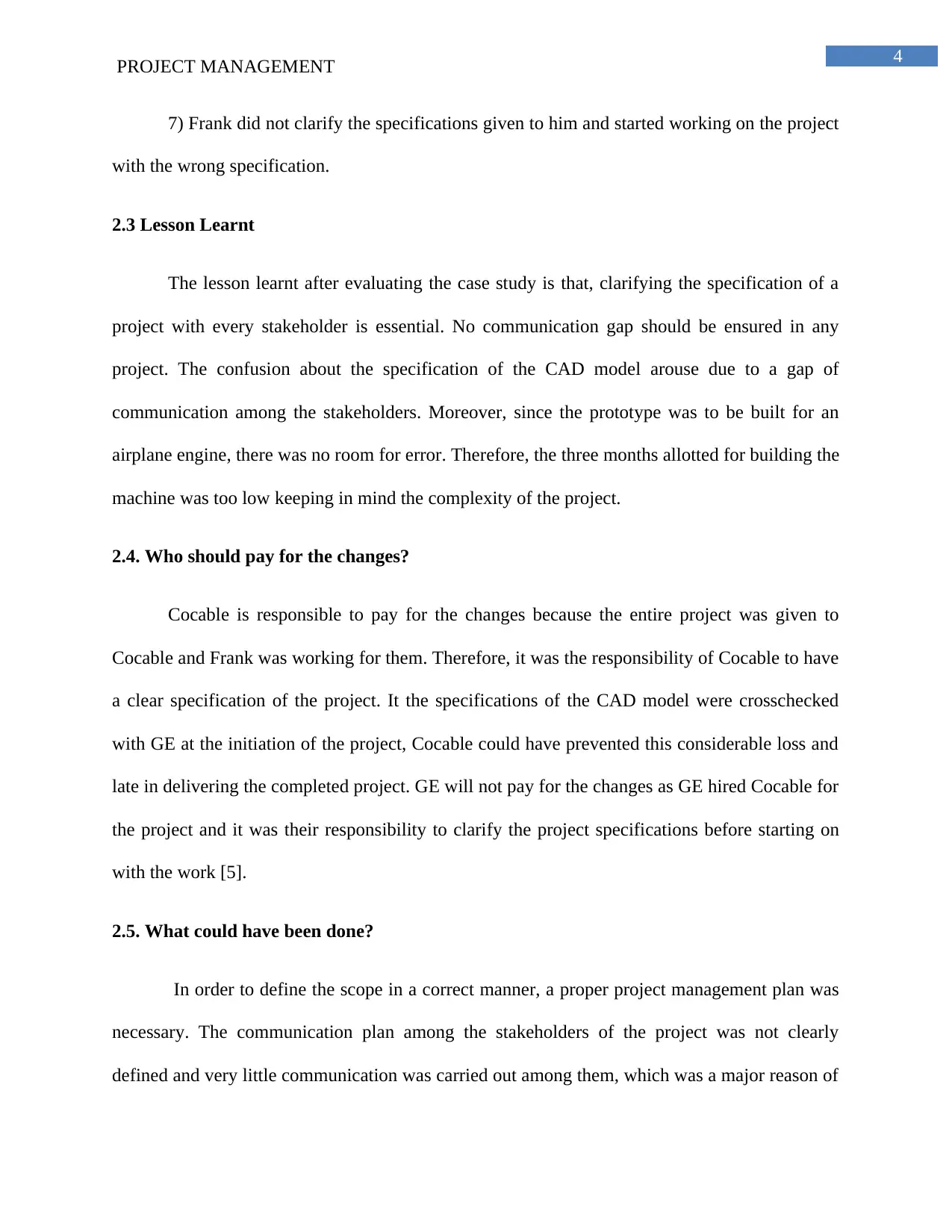
4
PROJECT MANAGEMENT
7) Frank did not clarify the specifications given to him and started working on the project
with the wrong specification.
2.3 Lesson Learnt
The lesson learnt after evaluating the case study is that, clarifying the specification of a
project with every stakeholder is essential. No communication gap should be ensured in any
project. The confusion about the specification of the CAD model arouse due to a gap of
communication among the stakeholders. Moreover, since the prototype was to be built for an
airplane engine, there was no room for error. Therefore, the three months allotted for building the
machine was too low keeping in mind the complexity of the project.
2.4. Who should pay for the changes?
Cocable is responsible to pay for the changes because the entire project was given to
Cocable and Frank was working for them. Therefore, it was the responsibility of Cocable to have
a clear specification of the project. It the specifications of the CAD model were crosschecked
with GE at the initiation of the project, Cocable could have prevented this considerable loss and
late in delivering the completed project. GE will not pay for the changes as GE hired Cocable for
the project and it was their responsibility to clarify the project specifications before starting on
with the work [5].
2.5. What could have been done?
In order to define the scope in a correct manner, a proper project management plan was
necessary. The communication plan among the stakeholders of the project was not clearly
defined and very little communication was carried out among them, which was a major reason of
PROJECT MANAGEMENT
7) Frank did not clarify the specifications given to him and started working on the project
with the wrong specification.
2.3 Lesson Learnt
The lesson learnt after evaluating the case study is that, clarifying the specification of a
project with every stakeholder is essential. No communication gap should be ensured in any
project. The confusion about the specification of the CAD model arouse due to a gap of
communication among the stakeholders. Moreover, since the prototype was to be built for an
airplane engine, there was no room for error. Therefore, the three months allotted for building the
machine was too low keeping in mind the complexity of the project.
2.4. Who should pay for the changes?
Cocable is responsible to pay for the changes because the entire project was given to
Cocable and Frank was working for them. Therefore, it was the responsibility of Cocable to have
a clear specification of the project. It the specifications of the CAD model were crosschecked
with GE at the initiation of the project, Cocable could have prevented this considerable loss and
late in delivering the completed project. GE will not pay for the changes as GE hired Cocable for
the project and it was their responsibility to clarify the project specifications before starting on
with the work [5].
2.5. What could have been done?
In order to define the scope in a correct manner, a proper project management plan was
necessary. The communication plan among the stakeholders of the project was not clearly
defined and very little communication was carried out among them, which was a major reason of
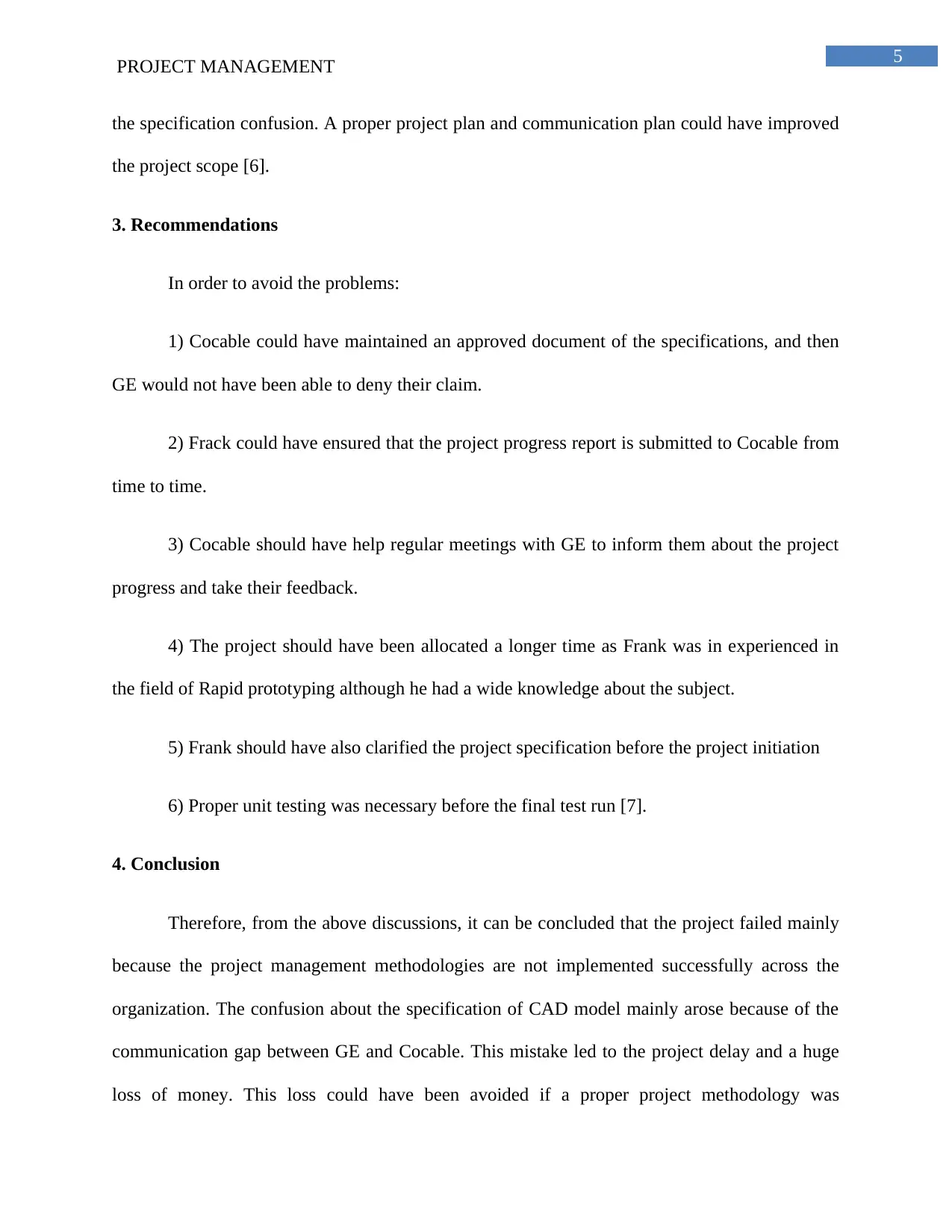
5
PROJECT MANAGEMENT
the specification confusion. A proper project plan and communication plan could have improved
the project scope [6].
3. Recommendations
In order to avoid the problems:
1) Cocable could have maintained an approved document of the specifications, and then
GE would not have been able to deny their claim.
2) Frack could have ensured that the project progress report is submitted to Cocable from
time to time.
3) Cocable should have help regular meetings with GE to inform them about the project
progress and take their feedback.
4) The project should have been allocated a longer time as Frank was in experienced in
the field of Rapid prototyping although he had a wide knowledge about the subject.
5) Frank should have also clarified the project specification before the project initiation
6) Proper unit testing was necessary before the final test run [7].
4. Conclusion
Therefore, from the above discussions, it can be concluded that the project failed mainly
because the project management methodologies are not implemented successfully across the
organization. The confusion about the specification of CAD model mainly arose because of the
communication gap between GE and Cocable. This mistake led to the project delay and a huge
loss of money. This loss could have been avoided if a proper project methodology was
PROJECT MANAGEMENT
the specification confusion. A proper project plan and communication plan could have improved
the project scope [6].
3. Recommendations
In order to avoid the problems:
1) Cocable could have maintained an approved document of the specifications, and then
GE would not have been able to deny their claim.
2) Frack could have ensured that the project progress report is submitted to Cocable from
time to time.
3) Cocable should have help regular meetings with GE to inform them about the project
progress and take their feedback.
4) The project should have been allocated a longer time as Frank was in experienced in
the field of Rapid prototyping although he had a wide knowledge about the subject.
5) Frank should have also clarified the project specification before the project initiation
6) Proper unit testing was necessary before the final test run [7].
4. Conclusion
Therefore, from the above discussions, it can be concluded that the project failed mainly
because the project management methodologies are not implemented successfully across the
organization. The confusion about the specification of CAD model mainly arose because of the
communication gap between GE and Cocable. This mistake led to the project delay and a huge
loss of money. This loss could have been avoided if a proper project methodology was
⊘ This is a preview!⊘
Do you want full access?
Subscribe today to unlock all pages.

Trusted by 1+ million students worldwide

6
PROJECT MANAGEMENT
considered for this particular project. The project development methodology applied in this case
has numerous loopholes and therefore, led to the significant loss. This could have been avoided
with a strategic approach towards the problem.
PROJECT MANAGEMENT
considered for this particular project. The project development methodology applied in this case
has numerous loopholes and therefore, led to the significant loss. This could have been avoided
with a strategic approach towards the problem.
Paraphrase This Document
Need a fresh take? Get an instant paraphrase of this document with our AI Paraphraser
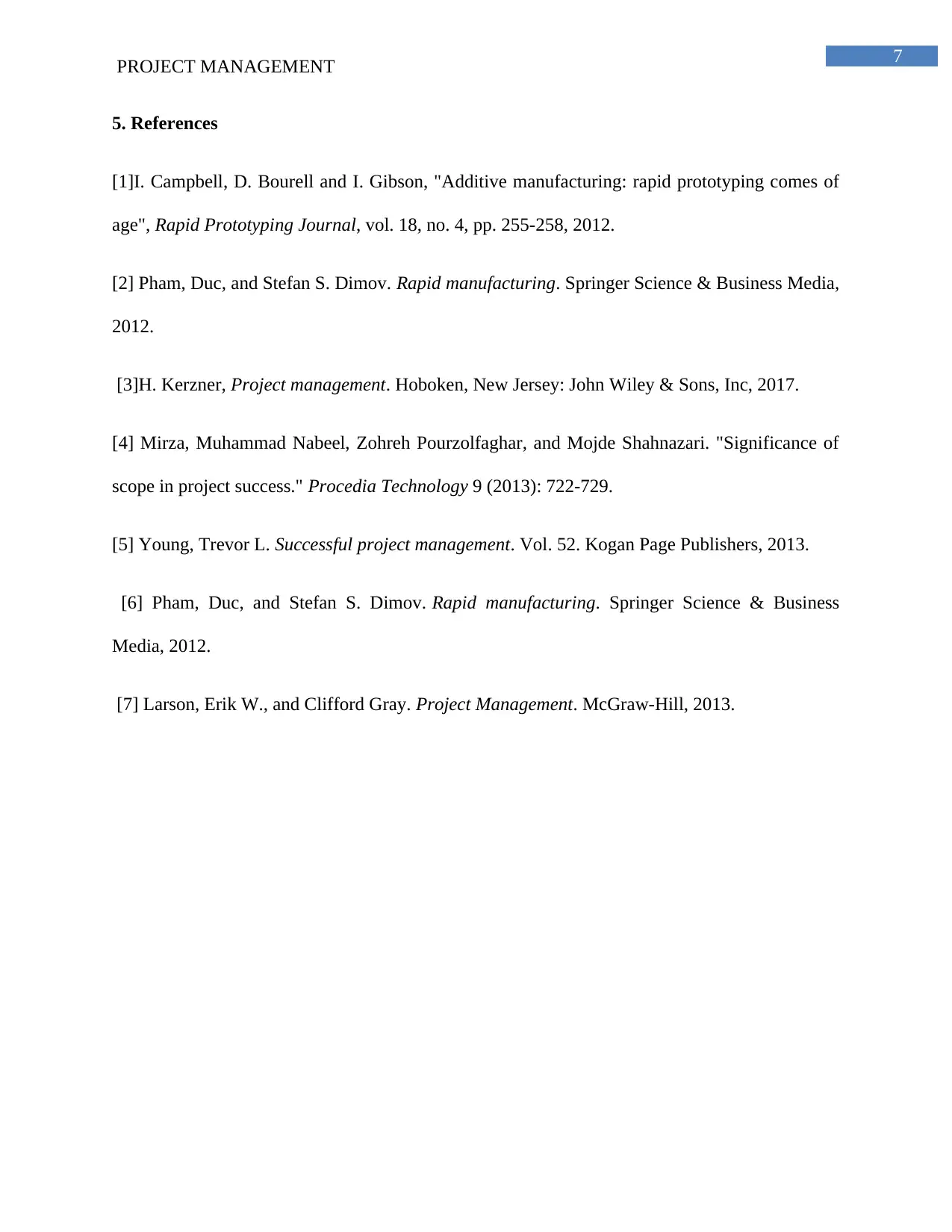
7
PROJECT MANAGEMENT
5. References
[1]I. Campbell, D. Bourell and I. Gibson, "Additive manufacturing: rapid prototyping comes of
age", Rapid Prototyping Journal, vol. 18, no. 4, pp. 255-258, 2012.
[2] Pham, Duc, and Stefan S. Dimov. Rapid manufacturing. Springer Science & Business Media,
2012.
[3]H. Kerzner, Project management. Hoboken, New Jersey: John Wiley & Sons, Inc, 2017.
[4] Mirza, Muhammad Nabeel, Zohreh Pourzolfaghar, and Mojde Shahnazari. "Significance of
scope in project success." Procedia Technology 9 (2013): 722-729.
[5] Young, Trevor L. Successful project management. Vol. 52. Kogan Page Publishers, 2013.
[6] Pham, Duc, and Stefan S. Dimov. Rapid manufacturing. Springer Science & Business
Media, 2012.
[7] Larson, Erik W., and Clifford Gray. Project Management. McGraw-Hill, 2013.
PROJECT MANAGEMENT
5. References
[1]I. Campbell, D. Bourell and I. Gibson, "Additive manufacturing: rapid prototyping comes of
age", Rapid Prototyping Journal, vol. 18, no. 4, pp. 255-258, 2012.
[2] Pham, Duc, and Stefan S. Dimov. Rapid manufacturing. Springer Science & Business Media,
2012.
[3]H. Kerzner, Project management. Hoboken, New Jersey: John Wiley & Sons, Inc, 2017.
[4] Mirza, Muhammad Nabeel, Zohreh Pourzolfaghar, and Mojde Shahnazari. "Significance of
scope in project success." Procedia Technology 9 (2013): 722-729.
[5] Young, Trevor L. Successful project management. Vol. 52. Kogan Page Publishers, 2013.
[6] Pham, Duc, and Stefan S. Dimov. Rapid manufacturing. Springer Science & Business
Media, 2012.
[7] Larson, Erik W., and Clifford Gray. Project Management. McGraw-Hill, 2013.
1 out of 8
Related Documents
Your All-in-One AI-Powered Toolkit for Academic Success.
+13062052269
info@desklib.com
Available 24*7 on WhatsApp / Email
![[object Object]](/_next/static/media/star-bottom.7253800d.svg)
Unlock your academic potential
Copyright © 2020–2025 A2Z Services. All Rights Reserved. Developed and managed by ZUCOL.





